Master Hot Tub Cover Measurements for Perfect Fit & Efficiency
June 20th, 2024
June 20th, 2024
There’s something undeniably comforting about slipping into a hot tub, especially when it’s perfectly maintained. But what many people overlook is the quiet hero of the hot tub world—the cover. This seemingly mundane accessory plays a crucial role in heat retention, water cleanliness, and safety. Yet, acquiring the right cover isn't just a matter of picking one off the shelf; it requires precise measurement. A cover that’s too small or too big brings more trouble than tranquility.
When I first got my hot tub, I underestimated the importance of a snug-fitting cover. I recall a particularly cold evening when I discovered that a poor-fitting cover allowed heat to escape, costing me both comfort and higher energy bills. This experience was a vivid reminder of the necessity for accuracy when measuring cover dimensions.
Understanding how to measure correctly involves more than just width and length; it requires a keen eye for details like corner radius and skirt length. Each hot tub is unique, and so is the method for measuring it. Tools like a flexible measuring tape become your best companions in this task. Knowing what to measure and having the right approach ensures that your hot tub cover fits perfectly, optimizing your relaxation space and protecting your investment. As you embark on this task, remember that precision is key to maintaining your backyard oasis.
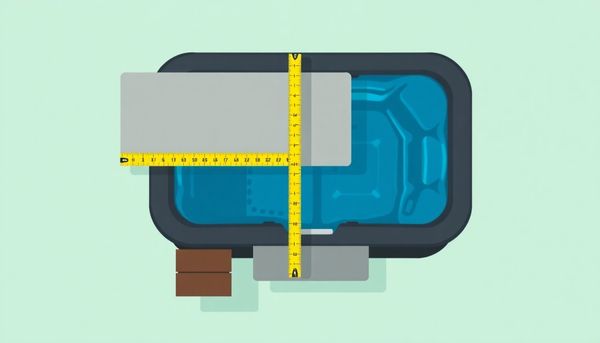
Corners of a hot tub often hold secrets, the kind that can trip you up if not handled with care. When you're measuring these pivotal points, having the right tools can make all the difference between a snug fit and a drafty disaster. One approach is to use a framing square. This L-shaped ruler simplifies the process, helping you determine the corner radius without the fuss of complex calculations. If a framing square isn't at your disposal, two rulers taped together at their zero ends can serve as an effective alternative.
Once armed with your tool, position it against the hot tub corner. The spot where the tub's curve meets the ruler reveals the critical corner radius measurement. If rounding is necessary, always round down. This ensures the cover fits snugly, accommodating the broader curve of the tub itself. Remember, a smaller radius on paper translates to a larger curve on your cover, preventing unwanted gaps.
For those with a more hands-on approach, a piece of cardboard can offer a tactile solution. Lay it over the corner, trace the curve, and cut out your template. Measure the straight line from the curve's starting point to where it meets the edge of the cardboard. This straightforward method provides a visual guide, ensuring the cover wraps the corner precisely, much like a tailor fitting a jacket. Whether high-tech or hands-on, getting the corner measurements right is crucial for a cover that guards both warmth and water, perfectly tailored to your spa's unique shape.
Finding the right tools to measure your hot tub cover might feel like stepping into a craftsman’s workshop. Selecting the right equipment is crucial to ensure precision, and the framing square is a standout hero in this story. This L-shaped ruler may seem simple, yet it’s adept at measuring tricky corner radii—a task that can make or break a snug fit.
Imagine this: you’re holding not just one tool, but a multitasker designed for accuracy. A framing square's black gradations stand out against its non-glare finish, guiding you smoothly through your measurements. Its versatility extends beyond mere measurements; its guidebook offers insights even the most seasoned tradesmen appreciate. This little device can replace multiple tools in your kit, making it invaluable for both beginners and experts alike.
A standard tape measure also joins the cast, essential for gauging length and width. It’s the superhero's sidekick, ensuring you accurately capture dimensions from lip to lip, bypassing the outer cabinet’s deception. Two measurements are better than one when confirming straight sides, and a tape measure does this effortlessly.
Lastly, some retailers offer printable diagrams, a sort of blueprint for those who prefer a visual aid. These can verify measurements or serve as a backup plan if your tape measure and framing square decide to take the day off. With these tools in hand, achieving a flawless fit for your hot tub cover becomes more than a possibility—it becomes a certainty.
Precision is a must when tackling the often overlooked task of measuring the corner radius of a hot tub cover. Forgetting about this detail can lead to a cover that doesn't quite fit right, making it about as useful as a chocolate teapot. Start by gathering a few essential tools, such as a carpenter's square or two rulers. These trusty companions will help map out the curve neatly. If you're like me and still fond of a bit of hands-on crafting, you might prefer the tactile approach. Grab a piece of stiff paper or cardboard, place it over the corner, and trace along the curve. With scissors in hand, cut out this template and measure the straight line from where the curve begins to the tip of your cutout. This distance represents your corner radius.
A handy tip: when in doubt, always round down. Although it might sound counterintuitive, a smaller number on your measurement means a larger radius on the final cover, ensuring it fits snugly over your tub's curves. This subtle adjustment leaves no room for error, and you avoid any annoying gaps that can let in debris or allow heat to escape.
Ultimately, getting this measurement right ensures that your new hot tub cover fits like a dream, snugly sealing in warmth and keeping out unwanted dirt. It’s these small details that make a world of difference, transforming your backyard spa experience into something truly relaxing and hassle-free.
The skirt of a hot tub cover might not immediately capture your attention, but optimizing its length is crucial for both functionality and aesthetics. Unlike other measurements, this one requires a touch of finesse. Start by measuring from the top rim of your spa down to the bottom of the cabinet. If there's a ledge or lip, take your measurement from there, ensuring a snug fit that doesn’t leave room for wind and weather to sneak in.
Remember the awkward moment of finding your old cover bunched up, unable to seal properly? This mishap is often due to an ill-fitted skirt. Measure with precision, noting any peculiarities such as digital control panels that might interfere with the cover’s fit. You wouldn’t want a great cover folding awkwardly around controls, hindering access.
Consider the shape of your hot tub too. Unconventional designs, especially those with extra features, sometimes demand a custom approach. In these cases, detailed templates sent to manufacturers can save you headaches later. When measuring an existing cover, locate the seam under the foam and measure to the bottom, ensuring consistency.
An expertly measured skirt not only protects your spa from the elements but also contributes to energy efficiency by sealing in heat. It’s the quiet hero of hot tub covers, ensuring everything stays in its rightful place.
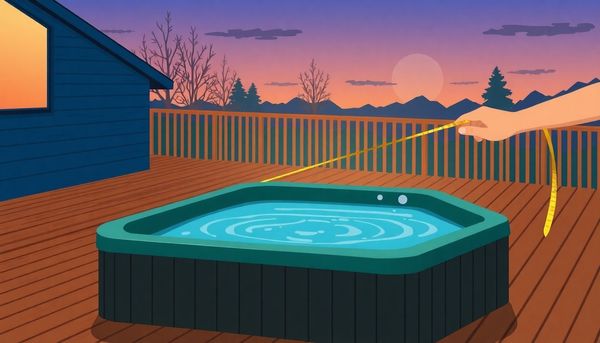
Imagine you're getting ready for a weekend of relaxation in your hot tub, only to find that your new cover doesn’t quite fit. This common frustration can be avoided with the right measurement tools in hand. Opt for a sturdy tape measure to ensure that your dimensions are precise and consistent. Unlike a flimsy ruler that may bend or give inconsistent readings over larger distances, a retractable tape measure offers flexibility and stability.
A framing square is another fantastic tool for measuring those pesky corner curves. This L-shaped instrument helps you determine the corner radius, which is crucial since many hot tubs feature rounded edges. Without accounting for this detail, you might end up with a cover that leaves corners exposed or awkwardly overlaps. If you don’t have a framing square, two rulers taped together at the zero end can serve as a handy substitute.
For hot tubs with unique shapes, such as octagonal or circular designs, a large piece of cardboard or a printable template can be invaluable. Lay it over the tub, trace, cut, and voila—you have a reference point for ordering a custom cover. Remember, accuracy is your ally here. Double-checking each measurement before you place an order can save you from a costly mistake and the hassle of returns, ensuring your cover fits seamlessly like a well-tailored suit.
Precision is at the heart of measuring hot tub dimensions, akin to a craftsman measuring for a bespoke suit. First, grab a tape measure and begin with the longest side of your hot tub. It’s crucial to measure from the outer lip of the acrylic tub, not the extended cabinet edge. Take the measurement at two different points to ensure accuracy, using the larger figure if discrepancies arise. This initial dimension, plus an additional inch for a snug fit, ensures your cover embraces the tub without excess tightness or looseness.
Next, turn your attention to the shorter side. Again, measure from lip to lip, and if your hot tub is octagonal, focus on one panel from point to point. Consistency here is key, so double-check your figures to avoid any pitfalls. This step not only helps in creating a perfectly fitting cover but also maintains your spa’s efficiency by minimizing heat loss.
Corners often pose a challenge. To tackle this, use a framing square for the radius or trace the curve onto a piece of cardboard to get an accurate reading. When rounding the corner measurements, always round down to ensure your cover fits snugly around the spa’s curved edges. Finally, don’t forget to measure the skirt length, which should hang just right to seal the tub without obstruction. This attention to detail ensures a perfect fit, resulting in a more energy-efficient and aesthetically pleasing spa experience.
Determining the corner radius of your hot tub cover may seem like a minor detail, but it plays an essential role in ensuring a snug fit. It starts with understanding that not every hot tub has perfectly square corners; many have rounded edges that require precise measurements. To capture this detail, a framing square becomes your best ally. This tool, with its L-shape and clear gradations, helps you measure the curve without fuss.
Imagine you’re measuring a roundabout on a miniature scale. Placing the framing square at the corner of your hot tub, you’ll notice where the tub touches the ruler. This intersection is your key to finding the correct radius. If you don’t have a framing square, you might use two rulers held together or even a template from your retailer. A little trick of the trade is using a piece of paper to trace the curve, then measuring the straight line from the start to the end of this arc on the paper.
It's crucial to remember not to overestimate this radius. If in doubt, round down slightly; a smaller number on paper means a larger radius in reality. This ensures your hot tub’s cover hugs the curves snugly, provides maximum insulation, and stays tightly sealed against the elements. Precision here saves you from potential misfits and ensures your hot tub's efficiency remains at its peak.
Evaluating the quality of a hot tub cover material involves more than just a quick glance or a feel of the fabric. When I was shopping for my own cover, I quickly learned how crucial it is to dig into the details. Consider this: the cover's exterior, typically crafted from marine-grade vinyl, isn't merely a fashion statement. This material is specifically chosen for its durability and resistance to water, mildew, and UV rays. When selecting a cover, pay attention to the vinyl’s weight, usually between 26 to 34 ounces per square yard. A higher weight signals a stronger, more durable material.
Beyond the surface, the core of the cover holds the real magic. Most covers are lined with dense foam insulation, which plays a critical role in heat retention. Cover densities vary; common options include one-pound, one-and-a-half-pound, and two-pound foam. The denser the foam, the better it is at keeping your hot tub water warm and your energy costs down. A cover that I once owned had a two-pound density, and the difference in heat retention was remarkable.
Another detail often overlooked is the vapor barrier. This plastic wrap, sealed around the foam, prevents moisture from penetrating and degrading the insulation. Look for covers with double-wrapped vapor barriers to ensure long-lasting performance. And don't forget those steel reinforcement bars. They provide stability and support, especially under heavy snow loads, proving invaluable in regions with harsh winters.
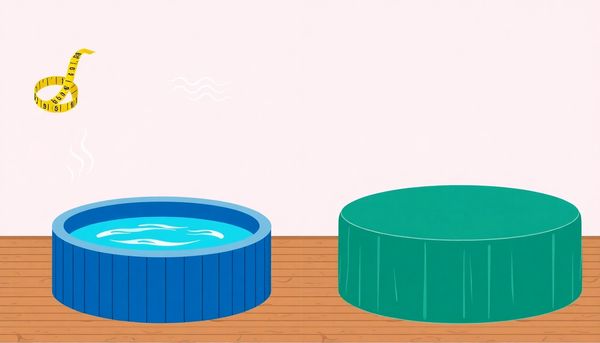
In the world of hot tubs, precision isn't just about getting the water temperature right; it's also about ensuring your hot tub cover fits like a favorite jacket. An ill-fitted cover can lead to energy loss, unwanted debris, and even a compromised relaxation experience. To make your hot tub cover your spa's best friend, you must start with meticulous measurements.
First, consider this: every hot tub has its unique quirks, from its shape to the radius of its corners. I once thought a simple ruler would suffice, only to realize how the tiniest deviation could affect the snugness of the fit. That’s when I upgraded to a framing square, which gives that much-needed accuracy without the frustration of guesswork.
Next, don't skip on measuring both the longest and shortest sides of your tub. It's tempting to eyeball it, but taking measurements in multiple spots ensures straightness and uniformity. Add an extra inch to each dimension to allow a half-inch of give on all sides. This prevents the cover from being overly taut, which could lead to unnecessary wear and tear.
Finally, the skirt measurement is crucial. This flap needs just the right length to seal properly without bulking up. A too-short skirt leaves room for heat to escape, while one that's too long might bunch and leave gaps. By carefully measuring from the top of your spa to the base, you ensure a cover that locks in warmth, saves energy, and keeps those leaves and twigs at bay.
A snug fit isn't just about aesthetics; it's about efficiency and longevity. With precise measurements, your hot tub cover becomes an essential partner in maintaining the perfect soak.
When it comes to ensuring your new hot tub cover fits like a bespoke suit, precision in measurement is your best ally. Think of your hot tub as a canvas, and it's your job to gather every detail. Start with the length and width, measuring across the longest and shortest parts from lip to lip of the acrylic tub—not the outer cabinet edge. This distinction is crucial, as it prevents the cover from sitting awkwardly or allowing heat to escape.
The corners of your hot tub may appear deceptively simple, yet they require a nuanced approach. A framing square becomes your best tool here, as it helps to find the radius of the curve accurately. Alternatively, crafting a cardboard template of the curve can provide an intuitive visual, making it easier to measure that elusive corner radius.
Let’s not overlook the skirt, that all-important overhang which helps seal the cover snugly. Measure from the top of your spa down to the bottom of the cabinet, avoiding any ledges or protrusions that could skew your results. Pay special attention to any control panels; a cover that accommodates them ensures ease of access every time you unwind.
For those with uniquely shaped hot tubs—perhaps with water features or integrated speakers—consider custom covers. Sometimes, a template sent to the manufacturer is the only way to achieve that perfect glove-like fit. Such careful planning and detail orientation ensure your investment not only protects but enhances your spa experience.
Choosing the right materials for your hot tub cover is akin to selecting the ideal armor for your spa. It goes beyond mere aesthetics; it’s about ensuring longevity and performance. When delving into material options, consider the marine-grade vinyl, often touted as the industry standard. This tough material is resilient against continuous water exposure, and the best variants come pre-treated for UV and mildew resistance, ensuring that your cover stays intact through all seasons.
The foam core inside the cover plays a pivotal role in insulation. Opt for a higher density, such as two-pound foam, which not only adds strength but also enhances heat retention. This density helps maintain the water temperature and reduces energy consumption. Don’t be swayed solely by R-value claims, as they can be inconsistent; instead, focus on foam thickness and density as more reliable quality indicators.
Galvanized steel reinforcement bars are another key feature. These bars provide structural support, distributing weight evenly and preventing sagging under heavy snow or debris. This is particularly crucial for those living in areas with harsh weather conditions. Lastly, ensure the vapor barrier, often a plastic film wrapping the foam, is robust, as it protects against moisture infiltration. By meticulously selecting these materials, you’ll ensure your hot tub cover not only fits perfectly but also stands the test of time.
Optimizing for energy efficiency is more than a practical concern; it's an art that can significantly impact your utility bills and environmental footprint. When selecting and measuring your hot tub cover, the goal is to ensure it seals tightly, minimizing heat loss. A well-fitted cover acts like a winter coat for your spa, keeping the warmth locked in and reducing the need for constant reheating.
Have you ever noticed the difference in your home’s temperature when a window is slightly ajar in the winter? Similarly, even a small gap in your hot tub cover can lead to substantial energy loss. By measuring accurately and choosing a cover that fits snugly, you create an effective barrier against heat escape and external debris. The key is precision, so take your time to measure each dimension carefully, including the corner radius and skirt length.
Materials matter too. Opt for covers with high-density foam and marine-grade vinyl, as these provide superior insulation. Consider the thickness of the foam; while a thicker cover keeps more heat in, it should still be manageable for you to handle. Remember, a well-chosen cover not only conserves energy but prolongs the life of your hot tub by protecting it from the elements. Investing in the right cover is like setting up a reliable shield, ensuring your spa remains a warm, inviting oasis without spiking your energy bills.
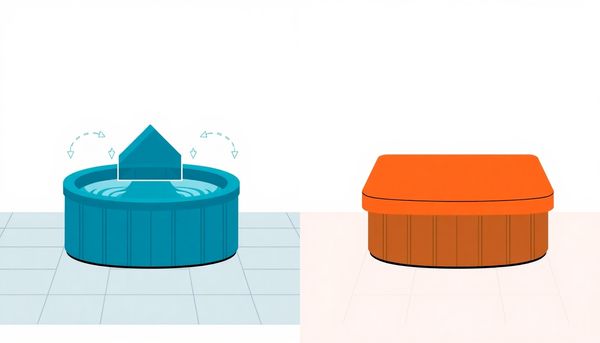
In the quest for the perfect hot tub cover, understanding the quality of the cover material is essential. It's not just about matching colors or textures; it's about ensuring durability, energy efficiency, and adequate protection for your spa. The cover material, often made from marine-grade vinyl, stands as the first line of defense against environmental elements. This vinyl's weight, which ranges from 26 to 34 ounces per square yard, plays a crucial role in determining its strength and resilience. A heavier vinyl typically offers better resistance to the sun’s UV rays and mildew, crucial for those who live in humid or sunny climates.
Moreover, the internal structure of the cover greatly influences its quality. High-density foam cores, often wrapped in a vapor barrier, prevent water absorption, which is crucial for maintaining insulation. This foam can have varying densities, with two-pound foam offering superior strength and heat retention compared to lighter options. Steel reinforcement bars, particularly galvanized ones, further enhance durability by providing resistance against chemical corrosion and supporting the cover under heavy loads like snow.
When you think about add-ons, safety features like built-in locks can be invaluable, especially for families with young children. These locks not only provide peace of mind but also ensure that your cover stays securely in place. Ultimately, investing in a high-quality cover means considering these factors to protect your hot tub effectively while also optimizing energy efficiency.
When it comes to measuring hot tub dimensions, precision is your best ally. Begin by securing a reliable tape measure and ensure your working area is free from obstructions. Start with the length, measuring from lip to lip across the longest side of your hot tub. This is crucial as the actual acrylic tub edge, not the outer cabinet, determines the fit of your cover. For accuracy, measure in two places and use the larger figure if there's a discrepancy. This method accounts for any irregularities or warping that may have occurred over time.
Turning to the width, the same lip-to-lip principle applies. Again, take this measurement at two points to ensure consistency. When measuring an octagonal tub, choose a panel and measure from point to point. A helpful tip: adding an extra inch to both length and width measurements allows for a snug fit, giving the cover half an inch of leeway on each side.
Corners often present a challenge due to their rounded nature. Using a framing square can simplify this process. Position it at the corner of the hot tub, and where the tub contacts the square is your corner radius measurement. If required, round this number down; smaller figures translate to a better-fitting cover. For more irregularly shaped spas, creating a cardboard template of your tub's corners can offer an additional layer of precision.
Lastly, don't overlook the skirt measurement. This flap should hang from the bottom edge of the cover to seal the tub effectively. Measure from the top of the spa cabinet to the bottom, considering any lips or ledges. With these thorough measurements, you're set to order a cover that fits just right, ensuring optimal functionality and aesthetic appeal.
Hot tub owners often focus on aesthetics, but the real game-changer lies in the durability of the cover material. Consider the punishing conditions a hot tub cover endures – from blazing sun and torrential rain to heavy snow and falling debris. It’s no small feat for a piece of vinyl to withstand such elements while remaining effective and attractive.
When my friend decided to upgrade her hot tub cover, she learned the hard way that not all materials are created equal. She had opted for a cheaper cover, only to find it mildewing and tearing within a year. This mishap highlighted the importance of investing in a marine-grade vinyl cover. These covers are often treated for UV and mildew resistance, offering protection against fading and degrading over time. The weight of the vinyl, ranging from 26 to 34 ounces per square yard, is a key indicator of its strength.
Another critical component is the vapor barrier. If the plastic film wrapping the foam core is insufficient, moisture can seep in and compromise the cover’s insulation properties. Over time, as this barrier breaks down, a well-made cover can extend its lifespan with regular maintenance and inspection. Reinforcements, such as galvanized steel bars, also contribute to durability, preventing sagging under weight.
Ultimately, a well-chosen hot tub cover stands as your spa’s front line of defense, ensuring long-lasting performance and comfort. Skimping on quality might save a few bucks today, but a durable cover pays off in longevity and reduced energy costs.
A well-fitted hot tub cover isn’t just a snug accessory; it’s the guardian of your spa’s efficiency and cleanliness. Ever had a sweater that was just slightly too tight or too loose? That’s the difference between a wasteful hot tub cover and one that performs like a champ. A precise fit ensures no gaps where heat can escape or debris can sneak in, keeping your tub ready and waiting for the next relaxing soak.
To tackle this, you’ll need to measure with meticulous attention. First, get the dimensions right by measuring from the tub's lip, not its cabinet edge, ensuring the cover sits flush with the acrylic tub. When measuring your corners, remember that rounded edges can vary. Using a framing square or even a simple cardboard cutout will help you nail down the corner radius with accuracy. Adding just an inch to the measurements can provide the right amount of give without compromising the seal.
But there's more to consider than just dimensions. Think about how the cover interacts with your setup. If it's too close to control panels, you’ll find accessing controls a nightmare. And for those with uniquely shaped hot tubs or extras like built-in speakers, custom orders—though sometimes daunting—are worth the effort to achieve that perfect glove-like fit. Ensuring the right fit isn’t just about numbers; it’s about creating an effortless extension of your spa experience.
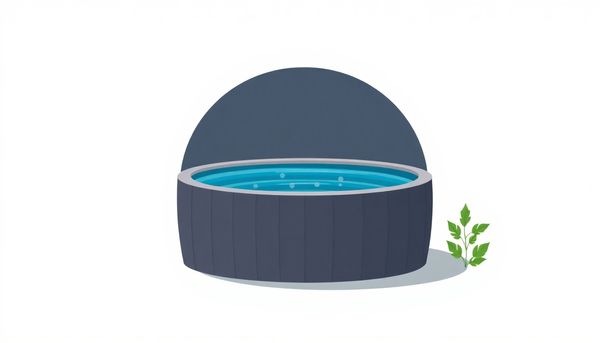
When it comes to safeguarding your hot tub cover from the unpredictable wrath of Mother Nature, a little foresight goes a long way. A friend once shared a tale of her hot tub cover, subjected to relentless wind and rain, which eventually gave in to the elements, leaving her hot tub exposed and vulnerable. This unfortunate scenario underscores the importance of choosing the right cover materials and design features to withstand various weather conditions.
Opt for a cover with marine-grade vinyl, renowned for its resilience against water and UV rays. This type of vinyl not only deflects rain but also resists fading under the sun’s harsh glare. To further reinforce against weather damage, consider a cover with a tapered foam core. This design cleverly prevents rainwater from pooling on the surface, which can lead to mildew or even break the cover under its weight.
Don’t overlook the role of a galvanized steel bar, which provides structural integrity, especially under heavy snowfall. For those living in areas prone to storms, investing in additional tie-down straps can offer extra security, keeping your cover in place during gusty conditions. Remember, the right cover doesn’t just protect your hot tub but also maximizes its energy efficiency by maintaining consistent heat levels, saving you on utility bills in the long run.
In essence, a well-chosen cover is like a suit of armor for your hot tub, ensuring it stands strong against the elements year-round. So, when selecting a cover, think of it as an investment in the longevity and performance of your spa.
Choosing the right cover material for a hot tub is like selecting a sturdy roof for your home. Both serve as guardians against the elements, and the wrong choice can cost you comfort and utility. When you're scouting materials, marine-grade vinyl often tops the list. It’s durable, designed to withstand the relentless bombardment of UV rays and stubborn mildew. Ever notice how your patio furniture fades over time? That’s UV damage. A high-quality vinyl, typically weighing between 26 and 34 ounces per square yard, can resist this fading and fend off moisture.
Beyond the outer layer, the foam core plays the role of insulation hero. Its density, ranging from one to two pounds, dictates how efficiently it retains heat. Think of it as the difference between a light summer blanket and a hefty winter quilt. For those living in chillier climates, a denser foam cover might be your best ally against escalating heating costs.
Then there’s the unsung hero, the vapor barrier—thin plastic film enclosing the foam. This barrier ensures that moisture doesn’t infiltrate, prolonging the life of the cover. But be vigilant, as the barrier degrades over time with exposure to steam and chlorinated water. Opting for covers with double-wrapped barriers offers added peace of mind.
Finally, consider safety features. In homes with curious children or pets, integrated locks transform this practical covering into a secure shield. Balancing aesthetics with functionality, the right cover material does more than just look good; it performs, protects, and endures.
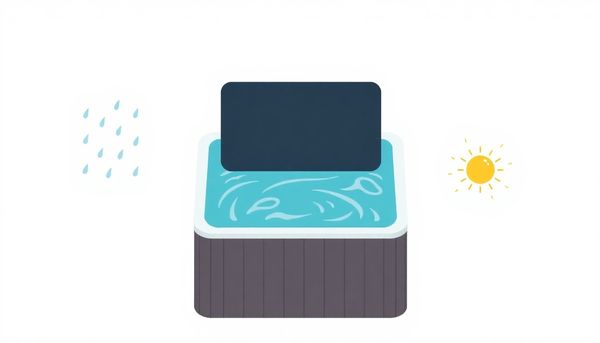
This article provided insights into maintaining your pool. Start your pool care journey today!
Want to become a pool maintenance expert? Our free Pool School course covers everything you need to know about pool care. From basic maintenance to advanced troubleshooting, you'll learn how to:
Join over 10,000 pool owners who have already transformed their pool care routine. Get started with our free Pool School course today!